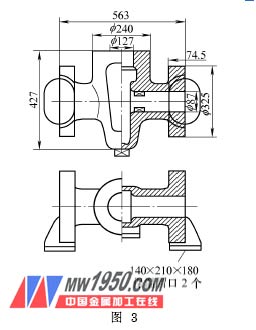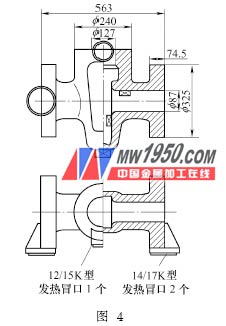Abstract: The high pressure valve used in the well control device has high working pressure and requires compact structure of the casting body. The conventional insulated riser process is adopted, because the size of the riser is large, the cutting is difficult, the process yield is low, and there is a large heat affected zone, which is unfavorable to the heat dissipation of the sand core, and the air shrinkage hole often appears in the lower part of the riser; The use of a hot riser can increase the process yield from the original 50% to 78%, and at the same time improve the heating condition of the sand core, and fundamentally solve the defect of the gas shrinkage cavity of the casting. 1. Process comparison and use of hot risers
The high pressure valve is one of the main components of the oil production and gas production wellhead device, and its body structure is shown in Figure 1. Technical requirements: Castings must not have casting defects such as cracks, shrinkage holes and inclusions. Leakage is not allowed after 70 MPa hydraulic pressure test; non-machined surfaces need to be tested for phosphors, no cracks are allowed; Wet magnetic powder inspection does not allow the presence of inclusions, pores and cracks. The material is ZG1Cr13. 
Our company has been engaged in the production of high-pressure valve casting bodies for many years, and has adopted the following three process schemes for production testing.
(1) The use of water glass quartz sand, because quartz sand has not been used very well so far, so when the valve body cavity processing, sanding often occurs, the surface quality is also very poor, and micro cracks often occur during flaw detection.
(2) Using water glass quartz sand core, the seat part of the casting is hot and isolated, and the method of placing the riser on the top (as shown in Figure 2) is required. However, due to the large size of the riser, it is difficult to remove, and the casting process yield is only For 50%, sand core sanding is difficult and very uneconomical. 
(3) The fur-resin sand is used as the core sand, and the process of insulating the riser is adopted in the upper part of the flange and the valve seat (as shown in Fig. 3). Due to the slow heat conduction of fur-resin sand, the heat preservation effect of the heat-insulating riser is not obvious, so the size of the riser is relatively large, and the core sand of the valve seat part causes a large amount of gas generation due to the heat of the top riser, which often makes the part A shrinkage hole is created and scrapped.
2. Application of fever riser
In view of the above situation, we use the hot riser for ZG1Cr13 high-pressure valve body castings, the cores are made of furo-resin sand, and the heat-diffuse riser is placed on the top of the middle flange and the side flange, and the valve seat is cooled by cold iron. In the method, the tail was also cooled by external cold iron (as shown in Figure 4), and the ZG1Cr13 high pressure valve casting was successfully produced. The structure of the casting is dense by anatomizing and coloring the casting body. Nearly 000 pieces have been produced, and the casting process yield rate is 78%-80%, and the genuine rate is over 96%. 

3. Conclusion
The castings made from fur «resin sand are smooth and accurate in size, but due to their slow heat conduction, if the ordinary fiber-type heat preservation riser is used, the heat preservation effect is not obvious. For high-alloys such as ZG1Cr13, etc., it is required to densely form the pressure-bearing steel castings of Figure 4. The heat-generating riser is used, and the heat preservation performance is obvious, which can significantly reduce the size of the riser, improve the process yield of the casting, and reduce the gas cutting, gouging, etc. The workload of the process, while the size of the riser is small, reduces the thermal impact on the sand core, can greatly reduce the probability of occurrence of the gas shrinkage hole, the genuine rate of the casting is obviously improved, and the economic effect is obvious.
Application of hot riser in ZG1Cr13 high pressure valve castings
